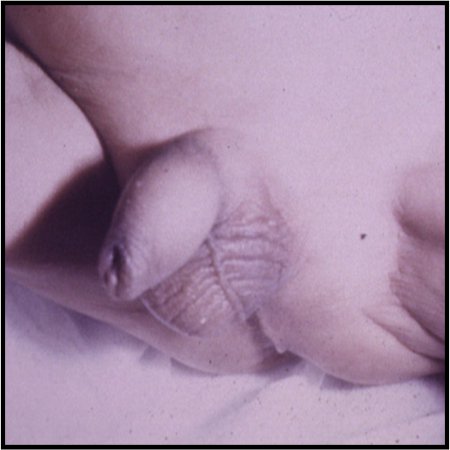Summary
Definition
History and exam
Key diagnostic factors
- presence of risk factors
- malpositioned or absent testis
- palpable cryptorchid testis
- non-palpable testis
Other diagnostic factors
- testicular asymmetry
- scrotal hypoplasia or asymmetry
- retractile testis
- ascending cryptorchidism
- hypospadias
- micropenis
- secondary sex characteristics/pubertal signs in prepubertal/pubertal patients
- surgical scar in the inguinal region
Risk factors
- family history of cryptorchidism
- prematurity
- low birth weight (<2.5 kg) and/or small for gestational age
- environmental exposures
- maternal alcohol use
- gestational diabetes
- prior inguinal surgery
Diagnostic investigations
Investigations to consider
- ultrasound
- magnetic resonance imaging (MRI)
- hormonal evaluation with human chorionic gonadotrophin (hCG) stimulation test
- hormonal evaluation with Mullerian inhibiting substance (MIS), inhibin B, and follicle-stimulating hormone (FSH)
- karyotyping
Treatment algorithm
Contributors
Authors
David J. Chalmers, MD

Pediatric Urology
Maine Medical Center
Portland
ME
Disclosures
DJC declares that he has no competing interests.
Acknowledgements
Dr David J. Chalmers would like to gratefully acknowledge Dr Gabriel Belanger, Dr Duncan T. Wilcox, and Dr Nicol Corbin Bush, previous contributors to this topic.
Disclosures
DTW and NCB declare that they have no competing interests.
Peer reviewers
Martin Koyle, MD
Professor Pediatric Urology
Hospital for Sick Children
Toronto
Canada
Disclosures
MK declares that he has no competing interests.
Paul J. Turek, MD
Professor of Urology
Endowed Chair
Urologic Education
The University of California
San Francisco
CA
Disclosures
PJT declares that he has no competing interests.
Vincent Gnanapragasam, MBBS, BMedSci, PhD, FRCSEng, FRCSEd(Urol)
Lecturer in Uro-oncology and Consultant Urological Surgeon
Department of Urology
Addenbrooke's Hospital
Cambridge
UK
Disclosures
VG declares that he has no competing interests.
Jørgen Thorup, MD, PhD
Professor and Head
Department of Pediatric Surgery
Rigshospitalet, University of Copenhagen
Copenhagen
Denmark
Disclosures
JT is an author of a reference cited in this topic.
Peer reviewer acknowledgements
BMJ Best Practice topics are updated on a rolling basis in line with developments in evidence and guidance. The peer reviewers listed here have reviewed the content at least once during the history of the topic.
Disclosures
Peer reviewer affiliations and disclosures pertain to the time of the review.
References
Key articles
Virtanen HE, Toppari J. Epidemiology and pathogenesis of cryptorchidism. Hum Reprod Update. 2008 Jan-Feb;14(1):49-58.Full text Abstract
Hutson JM, Clarke MC. Current management of the undescended testicle. Semin Pediatr Surg. 2007 Feb;16(1):64-70. Abstract
Kolon TF, Herndon CD, Baker LA, et al. Evaluation and treatment of cryptorchidism: AUA guideline. J Urol. 2014 Aug;192(2):337-45.Full text Abstract
European Association of Urology. Guidelines on paediatric urology. 2022 [internet publication].Full text
Kollin C, Stukenborg JB, Nurmio M, et al. Boys with undescended testes: endocrine, volumetric and morphometric studies on testicular function before and after orchidopexy at nine months or three years of age. J Clin Endocrinol Metab. 2012 Dec;97(12):4588-95. Abstract
Braga LH, Lorenzo AJ, Romao RLP. Canadian Urological Association-Pediatric Urologists of Canada (CUA-PUC) guideline for the diagnosis, management, and followup of cryptorchidism. Can Urol Assoc J. 2017 Jul;11(7):E251-60.Full text Abstract
Reference articles
A full list of sources referenced in this topic is available here.
Use of this content is subject to our disclaimer
